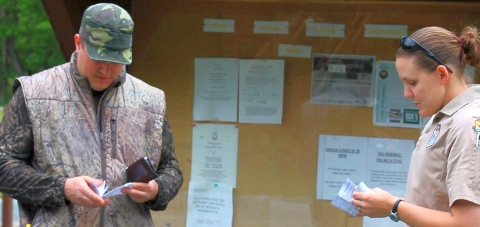What We Do
Federal wildlife officers safeguard America’s wildlife, habitat, and treasured federal lands and waters. Officers are equipped with a keen understanding of conservation rules and regulations, extensive training in progressive and proactive law enforcement practices, and genuine concern and affection for the outdoors.
Our officers are conservation officers first and foremost. From protecting king salmon in Alaska, to combating illegal reptile collection in Arizona, to enforcing manatee zones in Florida, to regulating waterfowl hunting and fishing in Oregon, federal wildlife officers face the challenges that game wardens in every state face. As guardians of wildlife, our officers ensure that wildlife-dependent uses are enjoyed in manner that protects natural resources now, and for the future. In all, federal wildlife officers help protect 850 million acres of lands and waters, home to some 392 threatened and endangered species, 700 species of birds, more than 1,000 fish species, and iconic species such as the American bison, elk and grizzly bear.
Who We Are
A federal wildlife officer is a law enforcement officer who combines conservation protection, traditional policing and emergency first response to protect, serve and educate the visiting public and the National Wildlife Refuge System staff. Among the most visible, essential and recognizable conservation professionals in the U.S. Fish and Wildlife Service, federal wildlife officers function as both guardians and ambassadors for national wildlife refuges and America’s wildlife.
Where We Work
Federal wildlife officers work in more than 560 national wildlife refuges and 38 wetland management areas that span more than 150 million acres. National wildlife refuges are found in all 50 states and all U.S. territories. Officers are assigned to a specific refuge or to a complex of refuges.
Federal wildlife officers work in various locations. They patrol for caribou hunters by plane in Alaska to prevent poaching of land crabs on beaches in the Caribbean. They contact dove hunters among the saguaro cactus of the Southwestern desert to conserve waterfowl in the wetlands and tall grasses of the Prairie. They protect nesting sea turtles on ocean beaches and safeguard sage brush steppe in the Great Basin. They use airboats to check anglers in the swamps of the Southeast and, on foot, they observe turkey hunters through the maples, oaks and poplars of New England,
Given the diverse landscapes and geographic locations that in which federal wildlife officers work, a wide variety of skills and abilities are needed in order to accomplish the job. Each refuge is different, so each federal wildlife officer’s job can vary greatly.
To glimpse more about law enforcement within the National Wildlife Refuge System, please see this short video, "A Day in the Life of a Federal Wildlife Officer."


